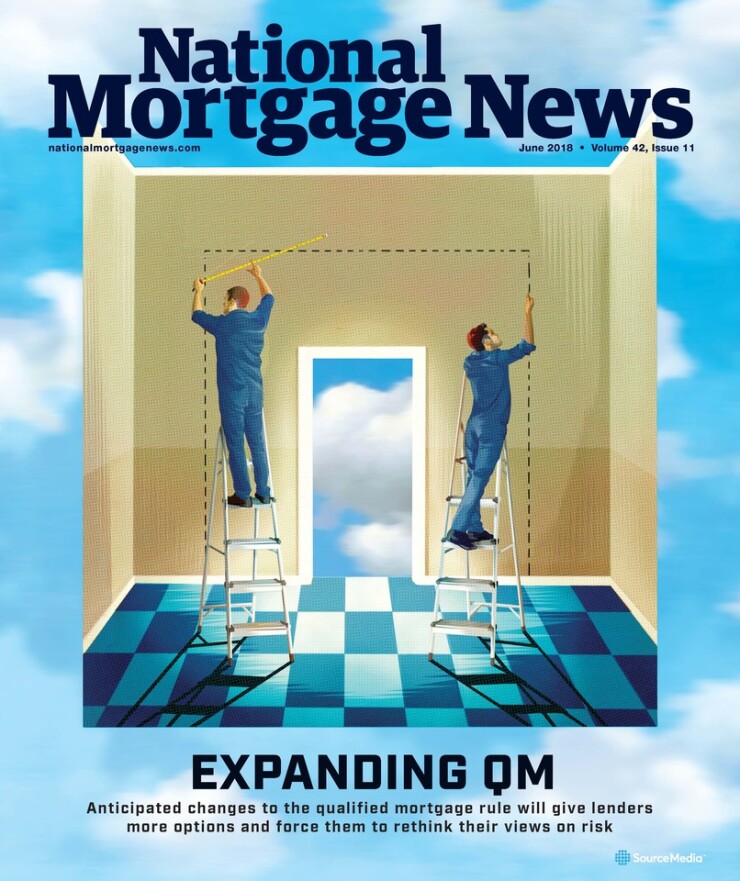
Editor's Note: This is part one of a two-part series on the future of the qualified mortgage rule from the June issue of National Mortgage News magazine.
With the Consumer Financial Protection Bureau in the midst of reviewing the qualified mortgage rule, mortgage lenders and the secondary market are closely watching to see if the more industry-friendly bureau will loosen some of the consumer protections established by the Dodd-Frank Act provision.
The result could be increased secondary market options for lenders, particularly if more loans meet the criteria of QM's safe harbor, which protects lenders from borrower legal challenges that a lender didn't follow the ability-to-repay rule.
Right now, the secondary market is perceived as having two flavors: the loan meets the qualified mortgage test or it doesn't. In the four years since the qualified mortgage rule have been in effect, an overwhelming number of loans originated has been in the safe harbor it provides to lenders.
The simplest and easiest way to stay in that harbor is to originate loans that are sold to Fannie Mae or Freddie Mac. Loans sold to the government-sponsored enterprises are
That's given the GSEs and loans originated for sale in Ginnie Mae securities a stranglehold on the QM market. And from a sales perspective, having fewer potential buyers doesn't necessarily provide the optimal price for the loan.
But absent further action either by the CFPB or Congress, the patch is set to expire when Fannie Mae and Freddie Max exit their government conservatorship or on Jan. 10, 2021, whichever comes first.

Meanwhile, the nascent non-qualified mortgage market sprung up because there are many
Non-QM is a broad category with a number of variations, unlike the plain-vanilla conforming lending. However, there are some options starting to creep in that are providing variety to the qualified mortgage market. That includes taking loans that are agency eligible into the private-label market because the seller can get a better price for them.
That changes the real dividing line for a mortgage lender's origination and exit strategy. Rather than making secondary market execution decisions based on whether the loan qualifies for the QM safe harbor, lenders may be better served evaluating whether the loan qualifies for purchase by Fannie Mae and Freddie Mac. In that context, even with a broader definition of what is a qualified mortgage, the nonagency space is going to expand as the market moves to serve those borrowers who couldn't get loans because lenders would not go outside the safe harbor.
In essence, the conventional mortgage secondary market could develop into a number of boxes, like agency QM; nonagency QM; agency-eligible private-label QM; and nonagency non-QM.
That variety could bring more investors to the market — and having more demand will likely mean better pricing, and profitability, for lenders.
After several years of little to no volume, non-QM originations and securitizations started to see significant levels of activity in 2017.

Only $369 million of non-QM mortgage-backed securities were issued in 2015, according to Nomura Securities. But year-over-year growth has been exponential. There was $990 million of issuance in 2016 and $3.9 billion in 2017.
And investors are bringing a variety of non-QM products to market, according to AllRegs, the investor product and underwriting guideline repository owned by Ellie Mae. About 26% of the investors that publish products on AllRegs Online added non-QM programs in 2017, representing nearly 25% of all new loan programs added to the platform last year.
Lenders originated between $7 billion and $9 billion in non-QM loans in 2017, more than double 2016's volume, Nomura estimates. And in 2018, non-QM securitization volume is projected to be between $10 billion and $11 billion, with originations in the $15 billion to $18 billion range.
Using 2004 as its base year — the last year before the subprime market became extremely frothy — Nomura extrapolated the growth opportunity for the non-QM market. It found non-QM loans to borrowers previously served by the Alt-A mortgage market could reach $100 billion in 10 years, while loans to borrowers with credit scores between 650 and 700 could generate an additional $40 billion to $60 billion in volume over the same time period.
However, those estimates do not account for any changes to the QM rule that can shift the market distribution. And based
In June 2017 — while the agency was still run by Richard Cordray — the CFPB solicited comments for a Dodd-Frank Act mandated review for both the QM rule and the ability-to-repay standard. The act provides the CFPB with broad statutory authority to amend the QM definition, said Laurence Platt, an attorney with Mayer Brown who represents mortgage companies.
"The expansion of the QM definition, that QM implied protection, actually helps nonagency lending."
— Ben Wu, executive director, LoanScorecard
The QM review is part of the five-year lookbacks on all Dodd-Frank Act provisions. As part of the review process, there were a total of 485 comments, with many that called for changes to the points and fees restrictions while others called for raising the debt-to-income ratio and/or changing documentation requirements.
"Virtually all of those could be handled through new rulemaking if the bureau wants to," Platt said.
When Dodd-Frank passed, Democrats controlled Congress and the White House, and the provision's supporters likely envisioned the CFPB using that authority to further tighten lending standards, not to broaden them.
The comments are asking for small changes to the rule. "That's what I call playing around the edges or playing around the margins, rather than, to use a basketball phrase, taking the ball to the hoop and trying to get it eliminated, rather than limiting its applicability," Platt said.
Mulvaney recently declared he wants to "bring some sanity" to the market, including significant changes to the QM rule. Platt compared Mulvaney's remarks to those of Tom Cruise's character in "Jerry Maguire," when he tells his client "help me help you." In other words, Mulvaney wants to make changes, but he needs more comments from the industry for direction.
In the QM request, "the responses were muted, modest. Notwithstanding the statutory provision, the CFPB has authority to completely eliminate the total points and fee test. So why argue about what should be in the test when you can get rid of the whole test?" Platt continued.
And other QM changes came from Congress. The
The clients of LoanScorecard do not look at the market split as being between QM-eligible and non-QM-eligible paper. "The clients we work with, it is not about non-QM as it is about nonagency," said Ben Wu, executive director of the automated underwriting system vendor that's a division of Calyx Software. "How much of the market is left underserved, where these nonagency players and product options may come into play."
If the CFPB is willing to loosen what it defines as a QM loan, "that would help the nonagency players more because more of their loans would have that legal protection that many believe exists. So in that sense, the expansion of the QM definition, that QM implied protection, actually helps nonagency lending," Wu said.





